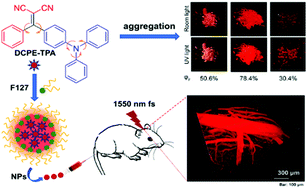Efficient red luminogen with aggregation-induced emission for in vivo three-photon brain vascular imaging†
Abstract
Nanoparticle-assisted deep-tissue fluorescence imaging is of great significance to bioimaging and disease diagnosis. Through the combination of the electron donor triphenylamine and electron acceptor cyan, the compound 1,1-dicyano-2-phenyl-2-(4-diphenylamino)phenylethylene (DCPE-TPA, 1) was synthesized and exhibited an aggregation-induced emission (AIE) effect. Compound 1 can form three kinds of aggregation states: orange crystals (1OC, 578 nm, ΦF = 50.6%), red crystals (1RC, 613 nm, ΦF = 78.4%) and deep-red emissive amorphous solids (1Am, 667 nm, ΦF = 30.4%) with notable differences in their emission wavelengths and quantum yields. The DCPE-TPA molecules are encapsulated with a polymeric matrix of Pluronic F-127 to form nanoparticles (NPs) that exhibit intense three-photon fluorescence (3PF) in the deep-red region as well as high stability, good photostability and good biocompatibility. Under a 1560 nm fs laser, the DCPE-TPA NPs are further utilized for in vivo 3PF imaging of the vasculature in the brain of a mouse at various vertical depths, producing a penetration depth of 300 μm with a high spatial resolution of 1.8 μm and a high signal-to-background ratio (SBR) of 14. A high-resolution three-dimensional (3D) model of the vasculature beneath the skull could be reconstructed. It is worth mentioning that such a high quantum yield for the deep-red emission of a purely organic material has rarely been reported.

- This article is part of the themed collections: 2020 Materials Chemistry Frontiers HOT articles and Recent Progress on Aggregation-Induced Emission


 Please wait while we load your content...
Please wait while we load your content...